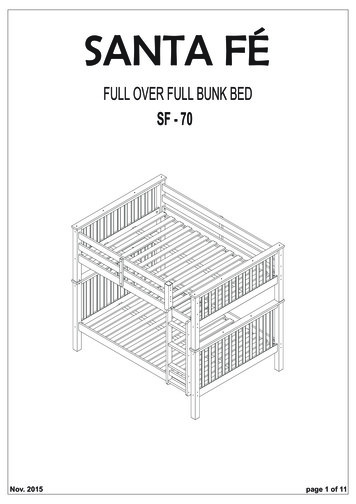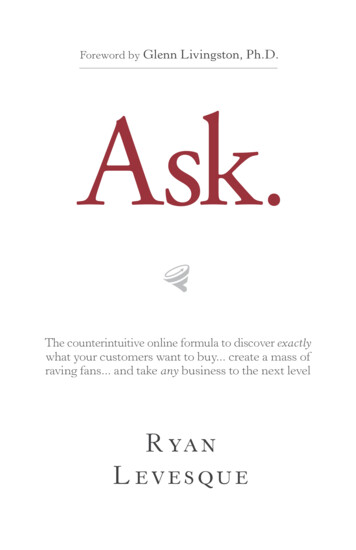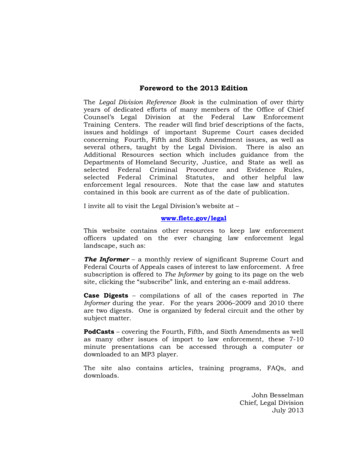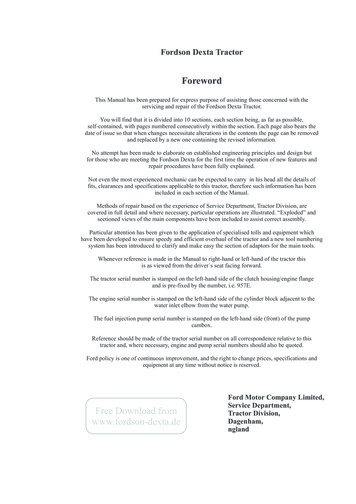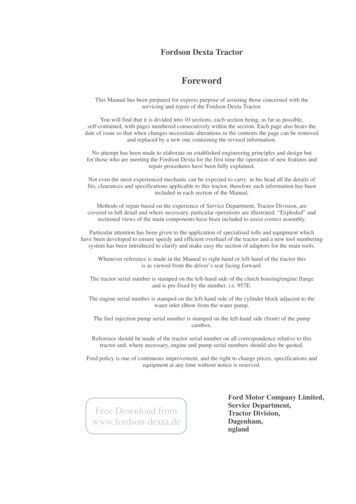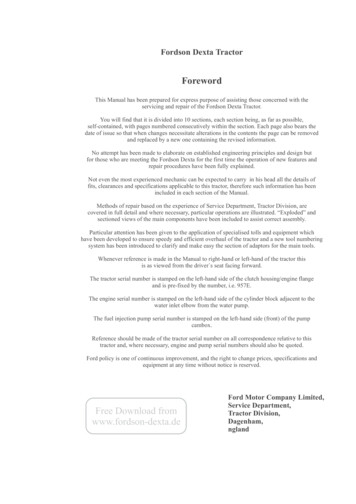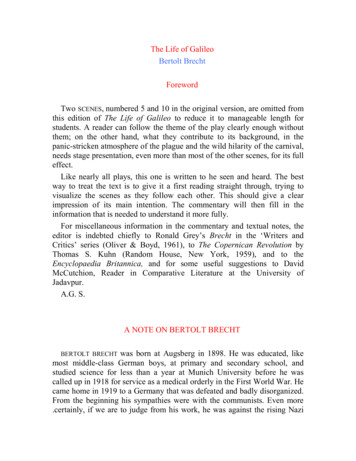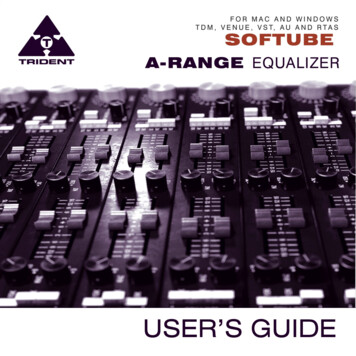
Transcription
Foreword by Malcolm ToftI have evaluated the Softube Trident A-Range equaliser plug-in atmy studio with some very experienced recording engineers. Afterexhaustive listening tests with many different instruments andvocals, I am pleased to say that we all agree this is an incrediblyaccurate software recreation of my original A Range design from1971.It exhibits all of the nuances of tone from the original, right downto the 'saturation' control which emulates the overdriven artifactsfrom the original when large amounts of equalisation are appliedor the input is driven hard.Well done to all the guys at Softube.Professor Malcolm ToftOriginal designer of the Trident A-Range consoleTorquay, Devon, EnglandDecember 17, 20092
Table of ContentsContact Details. 4Support. 4Installation and Authorization.5Introduction. 6About the Trident A-Range. 7User Interface. 8Equalizer Bands. 9Low Pass and High Pass Filters.10Phase Invert. 11Saturation. 11Output Volume. 11Key and Mouse Commands. 12Technical Side Notes.13Mono and Stereo Operation. 13RTAS on Pro Tools HD.13Buying Recommendations. 14System Requirements. 153
Contact DetailsIf you would like to get in touch with Softube, please e-mail info@softube.com.Alternatively, you could use the phone or send an old-fashioned mail (do you rememberenvelopes, stamps and paper?) to:Softube ABS:t Larsgatan 10cSE-582 24 LinköpingSwedenWeb: www.softube.comE-mail: info@softube.comPhone: 46 13 21 1623 (9 am – 5 pm CET)SupportOn the Softube website (www.softube.com) you will find answers to common questions(FAQ) and other topics that might interest you.Support questions can be posted at http://www.softube.com, where we will help you asfast as we can! 2010 SOFTUBE AB, SWEDEN. ALL PRODUCT AND COMPANY NAMES ARE TRADEMARKS OF THEIRRESPECTIVE OWNERS. SOFTUBE IS A REGISTERED TRADEMARK OF SOFTUBE AB, SWEDEN. ALLVISUAL AND AURAL REFERENCES TO THE TRIDENT A-RANGE ARE TRADEMARKS BEING MADE WITHWRITTEN PERMISSION FROM PMI AUDIO. THE TRIDENT, A-RANGE AND TRIANGLE LOGO ARETRADEMARKS OF PMI AUDIO GROUP, USED UNDER LICENSE. ALL SPECIFICATIONS SUBJECT TOCHANGE WITHOUT NOTICE. ALL RIGHTS RESERVED.THIS SOFTUBE PRODUCT IS PROTECTED BY PATENT SE525332 AND PENDING PATENTS US20040258250, EP1492081 AND JP2004-183976.4
Installation and AuthorizationIF YOU BOUGHT THE PRODUCT IN A BOXyou will have to register it in order to transfer thelicense to your iLok account:1.Go to http://www.softube.com/register to transfer the license to your iLokaccount. You will need the License Code found in the box, your iLok.comUser ID, and your iLok USB dongle. Follow the instructions on the web page.and have got the confirmation e-mail, the licensewill already be deposited in your iLok account:IF YO U B OU GH T THE PRO DU CT ONL INE2.Make sure that you have the latest iLok drivers installed. They can be found athttp://www.ilok.com.3.Log on to http://www.ilok.com and transfer the newly received license to yourphysical iLok dongle.4.Install the software from the DVD, or download the latest version fromhttp://www.softube.com/installers.Sometimes the DVD contains installers for all Softube products, but you will only be able torun those that you have acquired licenses for. In some cases, extra demo licenses areincluded when you buy a Softube product.5
IntroductionThe TridentTM A-Range is a legendary piece of equipment. As onlythirteen A-Range consoles were ever made, it remains a holy grail forsound engineers and producers around the world that hope to createequal works of art to those that were originally recorded on theA-Range – David Bowie's Ziggy Stardust, Queen, Elton John, the listgoes on.The A-Range was originally designed in the early 70's for TridentStudios in London by Malcolm Toft and Barry Porter. Toft was employedas a sound engineer at Trident Studios and when the studio needed a24 track recording console, he started Trident Audio Developments todesign and build the Trident A-Range. Other products followed andfound their way to studios around the world. Toft remains active to thisday, developing products under the Trident name.The A-Range plug-in from Softube is the first and only native plug-inthat has been fully endorsedby Toft and TridentAudio.6
About the Trident A-RangeThe plug-in version of the A-Range is modeled after a channel on one of the original 13Trident A-Range consoles. This particular channel strip is channel number 15 from SweetSilence Studio 'B' in Denmark and was borrowed from Danish producer FlemmingRasmussen. The A-Range console has been in Rasmussen's care for a long time and usedby Flemming Rasmussen when recording albums such as Metallica's Ride the Lightning,Master of Puppets and .And Justice for All.The A-Range channel features four bands of equalization and high and low pass filters, thesound of the filters are often referred to as “colorful” and “musical”. When running a hotenough signal through the original unit and boosting the bands it is possible to get it todistort, the sound is a hairy and effective saturation that is just right in some situation andjust wrong in others! Eventhough the unit was neverdesigned to distort, it hasdefinitely been usedthis way by renownedproducers and wethought it was onlyappropriate to staytrue to the original unitand add the saturationto the plug-in as anoption!7
User InterfaceThe layout of the A-Range equalizer is simple and easy. You have four different bands ofequalization, with a frequency selector knob and a gain fader each. Low and High Passfilters can be activated by pressing the off-white buttons, and a handy Phase Invert switchis found on the right side of the panel. The Saturation knob engages the consolesaturation, and is best used as a subtle effect. If you don't wish to get saturation, just put itin the OFF position and all saturation circuits will be de-activated.The A-Range console was actually designed to have very little distortion, but it wasnevertheless possible to crank up the input volume and equalization bands to make itdistort, an effect that has been of much use in lots of recordings. The actual amount ofsaturation depended heavily on the audio material and amplification before the console, sowe added the Saturation knob to make things easier for you. If all bands are set to zerogain, Saturation on its default position (12 o'clock) and Output Volume on 0 dB, theA-Range plug-in will have unity gain.8
Equalizer BandsThe four equalizer bands have two controls each – a“frequency selector” knob and a gain fader. The fader willboost the signal up to 15 dB by dragging the fader to theright and attenuate the signal by 15 dB by dragging it tothe left.High shelving band (top)and high mid band (bottom).High Shelving BandThe frequency options for the High Shelving Band are 15 kHz, 12 kHz, 10 kHz and 8 kHz.When boosted, the High Shelving Band gives a beautiful high-end shimmerto just about any material. Don't be afraid to try it on a master bus, as the resultcan be fantastic!High Mid BandThe High Mid Band is of bell type with the following center frequencies: 9 kHz, 7 kHz,5 kHz and 3 kHz.The bell filters interacts with each other in a rather funny way. For example,even if the gain of the Low Mid Band is set to zero, changing the frequency ofthat band will affect the frequency response of the High Mid Band filtersignificantly. The results are quite unpredictable and this is part of the reasonfor the unusual sound of the A-Range!9
Low Mid BandThe Low Mid Band is of bell type with the followingcenter frequencies: 2 kHz, 1 kHz, 500 Hz and 250 Hz.Low Shelving BandThe frequency options for the Low Shelving Band are150 Hz, 100 Hz, 80 Hz and 50 Hz.Low mid band (top) and thelow shelving band (bottom).Low Pass and High Pass FiltersThe Low Pass and High Pass filters are controlled by three buttonsrespectively, which sets the cut-off frequency for the filters – 15 KHz,12 kHz and 9 kHz for the Low Pass and 100 Hz, 50 Hz and 25 Hz for theHigh Pass. The cut-off characteristic is unusual and not exactly coherentbut the slope is about 12 dB per octave.The three settings work independently and can be used in any combinationwhich means that the more buttons you engage, the more attenuation you get.For example, pressing all three Low Pass buttons will actually result in a filterwith an even lower cut-off frequency than 9 kHz.10
Phase InvertThe Phase button inverts the phase whenpressed (as seen in the picture).SaturationThe Saturation or distortion of the A-Range isplaced after the equalizer bands and isdepending on the gain settings of the bands.A louder or “hotter” signal will make the unitdistort more and a weaker signal will make itdistort less.The Phase switch, Saturation knob andindicator LED and the Output Volume.To be able to handle signals of different volumes and to make up for equalizer bandsettings we added a Saturation knob that basically is a volume compensated input gainfor the saturation circuits. The LED next to the saturation knob indicates when the signal isbeing distorted. If you want to be sure not to add any saturation to the sound, click the“OFF” label and the saturation circuit will be bypassed.You will get the best result if the saturation is used sparingly on percussivesounds, like a drum bus. Let it take care of occasional peaks, and do not runit too hot.Output VolumeThe Output knob controls the output volume from the plug-in. The range of the outputvolume is -30 dB to 10 dB.11
Key and Mouse CommandsAll labels (such as the dB or frequency labels) areclickable. This allows you to easy select a setting byclicking on the wanted value. Hovering above a label willturn the mouse pointer into a pointing hand.Mouse UP/DOWN:Change a parameter, such as a knob or a switch. CLICK:Clicking on labels or activate the “About” box. MOUSE WHEEL(Mac only):Use the mouse wheel to change parameters.Keyboard CommandsUse these key commands while changing a parameter. FINE ADJUST:Figure 1: From top tobottom: Knob- and switchchanging cursor, Labelcursor and the “About”box cursor.Command (Mac) or Control (Win) R E S E T T O D E FA U LT :Alt (while clicking on the knob or fader).Pro Tools Specific Keyboard Commands AUTOMATION CONTROL WIND OW :Control Command Alt click (Mac) or Control-Windows-Alt-click (Windows) S HO W AU T O M AT IO N T R A C K:Control Command click (Mac) or Control-Windows-click (Windows)12
Technical Side NotesMono and Stereo OperationThe T R I D E N T A - R A N G E plug-in is designed to work in both stereo and mono. How thedifferent modes are selected depends on your host software. In most hosts you can selectthese when you select the plug-in. In other cases, inserting one the plug-in on a monotrack will usually make it use the M O N O mode, while selecting it on a stereo track makes ituse the S T E R E O mode.TDM/RTAS Stereo OperationTDM stereo is not supported due to DSP limit constraints. You will need to use the “ M U L T I M O N O ” mode instead of S T E R E O mode. Normal S T E R E O mode is however available inRTAS. If you plan to use “deck change” (online switching between RTAS and TDM), youshould always use the M U L T I - M O N O mode instead of S T E R E O mode, otherwise deckchange won't work.RTAS on Pro Tools HDThere are some specific issues to consider when using an RTAS plug-in in recording modeon a Pro Tools HD system. First of all, an audio buffer latency is introduced in the RTASversion.Secondly, all RTAS plug-ins are automatically bypassed in recording mode, unless anTDM plug-in is inserted on the insert slot before the RTAS plug-in.Enabling the plug-in in recording mode (Pro Tools HD 7 or higher): Insert a TDM plug-in (such as the “Trim” plug-in) on your track. Insert the Trident A-Range plug-in as RTAS on an insert slot after the TDM plug-in.Please see your Pro Tools reference guide for more info.13
Buying RecommendationsWe always make buying recommendations in our manuals for a hardware equivalent of theplug-in. In this case, it's really simple and really hard – If you can find an A-Range channeland can afford it, get it!This is a photo of channel 15 and 18 from one of the original Trident A consoles. Thesetwo are the ones we measured for the A-Range plug-in. A few cosmetic changes havebeen made to these units while at the Sweet Silence Studios: the original flip switches onthe Mute button has been changed to big red switches, the gray fader handles have beenchanged to bright yellow, and three frequency selector knobs have also been replaced.But it has the original face plate color, a strange but beautiful aubergine style purple!14
System RequirementsSupported sample rates: 44.1, 48, 88.2, 96, 176.4 and 192 kHz, in both mono and stereo.All native versions Mac OS 10.4 (or higher) on a G4 or Intel CPU (or higher) Windows XP (or higher) on a PIII CPU (or higher) 512 MB RAM Any VST, Audio Units or RTAS (Pro Tools 7 or higher) compatible host application iLok USB key and the latest iLok drivers (download them from http://www.ilok.com) DVD drive or Internet access for installationTDM and VENUE versions Pro Tools HD Accel card is required Pro Tools HD compatible systemPlease, make sure that you always use the latest iLok driver. It is not included in theSoftube installer, but can be downloaded from www.ilok.com.15
Trident A-Range plug-in was made by: Niklas Odelholm – modeling, Oscar Öberg – DSPprogramming and modeling. Torsten Gatu – framework programming. Arvid Rosén –framework programming. Ulf Ekelöf – 3D rendering. Original hardware was designed byMalcolm Toft and Barry Porter at Trident Audio Developments. The original unit is ownedby Flemming Rasmussen at Sweet Silence Studios. 2010 Softube AB, Sweden
Torquay, Devon, England December 17, 2009 2. . THE TRIDENT, A-RANGE AND TRIANGLE LOGO ARE TRADEMARKS OF PMI AUDIO GROUP, USED UNDER LICENSE. ALL SPECIFICATIONS SUBJECT TO CHANGE WITHOUT NOTICE. ALL RIGHTS RESERVED. . SHO W AUT O MAT ION T RACK: Control

